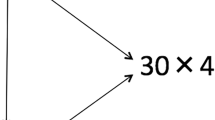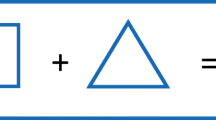Abstract
We studied a group of fourth grade students identified by their classroom teachers as having ‘above average ability’ in mathematics who were participating in ‘pull-out’ enrichment sessions. We sought to test, using observational and microgenetic methods, hypotheses regarding students' measurement strategies that have been generated post hoc by other research teams. These above-average mathematics students did not show initial difficulties with turn commands previously reported in mixed populations. They created strategies to accurately determine the correct direction of turn and to estimate the amount of turn. They did follow a similar developmental order as students in previous work: They synthesized and integrated two schemes, turn as body movement and turn as number. Analyses extending this work revealed a process of psychological curtailment in which students gradually replace full rotations of their bodies with smaller rotations of an arm, hand, or finger.
Similar content being viewed by others
REFERENCES
Anderson, J.R. (eds.): 1993, Rules of the mind. Hillsdale, NJ: Lawrence Erlbaum.
Clements, D.H. and Battista, M.T.: 1989, 'Learning of geometric concepts in a Logo environment', Journal for Research in Mathematics Education 20, 450-467.
Clements, D.H. and Battista, M.T.: 1990, 'The effects of Logo on children's conceptualizations of angle and polygons', Journal for Research in Mathematics Education 21, 356-371.
Clements, D.H. and Battista, M.T.: 1992, 'Geometry and spatial reasoning', in D.A. Grouws (ed.), Handbook of research on mathematics teaching and learning, Macmillan, New York, pp. 420-464.
Clements, D.H., Battista, M.T., Sarama, J. and Swaminathan, S.: 1996, 'Development of turn and turn measurement concepts in a computer-based instructional unit', Educational Studies in Mathematics 30, 313-337.
Clements, D.H., Battista, M.T., Sarama, J., Swaminathan, S. and McMillen, S.: 1997, 'Students' development of length measurement concepts in a Logo-based unit on geometric paths', Journal for Research in Mathematics Education 28 (1), 70-95.
Clements, D.H. and Meredith, J.S.: 1994, Turtle math [Computer program], Logo Computer Systems, Inc. (LCSI), Montreal, Quebec.
Clements, D.H. and Sarama, J.: 1995, 'Design of a Logo environment for elementary geometry', Journal of Mathematical Behavior 14, 381-398.
Cope, P. and Simmons, M.: 1991, 'Children's exploration of rotation and angle in limited Logo microworlds', Computers in Educ. 16, 133-141.
El'konin, D.B. and Davydov, V.V.: 1975, 'Children's capacity for learning mathematics', in L.P. Steffe (ed.), Soviet studies in the pyschology of learning and teaching mathematics. University of Chicago, Chicago.
Johnson, M.: 1987, The body in the mind, The University of Chicago Press, Chicago.
Kieran, C.: 1986, 'Logo and the notion of angle among fourth and sixth grade children', in Proceedings of the Tenth Annual Conference of the International Group for the Psychology of Mathematics Education, City University, London, England, pp. 99-104.
Kieran, C., Hillel, J. and Erlwanger, S.: 1986, 'Perceptual and analytical schemas in solving structured turtle-geometry tasks', in C. Hoyles, R. Noss and R. Sutherland (ed.), Proceedings of the Second Logo and Mathematics Educators Conference, University of London, London, England, pp. 154-161.
Krainer, K.: 1991, 'Consequences of a low level of acting and reflecting in geometry learning-Findings of interviews on the concept of angle', in F. Furinghetti (ed.), Proceedings of the Fifteenth Annual Conference of the International Group for the Psychology of Mathematics Education, Program Committee, 15th PME Conference, Assisi, Italy, pp. 254-261.
Krutetskii, V.A.: 1976, The psychology of mathematical abilities in schoolchildren, University of Chicago Press, Chicago.
Laborde, C.: 1996, 'A new generation of diagrams in dynamic geometry software', in E. Jakubowski, D. Watkins and H. Biske (ed.), Proceedings of the Eighteenth Annual Meeting of the North America Chapter of the International Group for the Psychology of Mathematics Education. Columbus, OH.
Magina, S. and Hoyles, C.: 1997, 'Children's understandings of turn and angle', in T. Nunes and P. Bryant (ed.), Learning and teaching mathematics: An international perspective, Psychology Press, East Sussex, England, pp. 99-114.
Mitchelmore, M.C.: 1998, 'Young students' concepts of turning and angle', Cognition and Instruction 16, 265-284.
Noss, R.: 1987, 'Children's learning of geometrical concepts through Logo', Journal for Research in Mathematics Education 18, 343-362.
Olive, J., Lankenau, C.A. and Scally, S.P.: 1986, Teaching and understanding geometric relationships through Logo: Phase II. Interim Report: The Atlanta-Emory Logo Project, Emory University, Atland, GA.
Siegler, R.S.: 1996, Emerging minds: The process of change in children's thinking, Oxford University Press, New York.
Steffe, L.P.: 1994, 'Children's multiplying schemes, in G. Harel and J. Confrey (ed.), The development of multiplicative reasoning in the learning of mathematics, SUNY Press, Albany, NY, pp. 3-39.
Author information
Authors and Affiliations
Rights and permissions
About this article
Cite this article
Clements, D.H., Burns, B.A. Students' Development of Strategies for Turn and Angle Measure. Educational Studies in Mathematics 41, 31–45 (2000). https://doi.org/10.1023/A:1003938415559
Issue Date:
DOI: https://doi.org/10.1023/A:1003938415559




